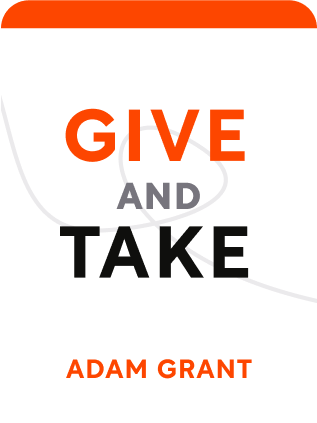

This article is an excerpt from the Shortform book guide to "Give and Take" by Adam Grant. Shortform has the world's best summaries and analyses of books you should be reading.
Like this article? Sign up for a free trial here .
Do you want to level up your networking game? What is the key to building strong, personal ties?
According to Adam Grant, the author of Give and Take, the key to building a social network is to be a giver. Grant explains that takers and matchers usually have small networks because recipients either feel like they’re being manipulated, or the give-take relationship is a quid pro quo. Givers, on the other hand, grow large networks because they give to many people, not knowing who might be helpful down the road.
Keep reading for tips on how to build a network, according to psychologist Adam Grant.
How Givers Build Networks
If you want to know how to build a network, take Adam Grant’s advice. Networks provide private information, diverse skills, and power. Givers tend to create more helpful networks than matchers or takers.
The core of why giving works in building networks is that you can’t perfectly predict who will be useful to you in the future. Someone you help might unpredictably become your boss or client in the future. If you selectively target only people you believe will help you, you ignore all the unproven people whose connections would have turned out to be helpful. Plus, because most people professionally tend to be matchers, the “lower status” people you help as a giver tend to really appreciate your giving.
In contrast, takers and matchers take advantage of the reciprocity tendency. They offer favors to people whose help they want in the future. But there are two downsides to this approach. First, the recipients often feel like they’re being manipulated. This ends up feeling like a transaction more than a meaningful gesture. Second, matchers tend to build smaller networks than givers or takers, because they help only people for whom there is an immediate benefit. Thus, matchers tend to have a smaller network of ties that are made up of quid pro quo relationships.
“The true measure of a man is how he treats someone who can do him absolutely no good.” – Samuel Johnson
Weak Ties and Dormant Ties
Your social networks are composed of strong ties and weak ties. Strong ties are people whom you’re very close to, people you might invite over for dinner. Weak ties are acquaintances, people you know on a casual basis.
Surprisingly, people are much more likely to benefit from weak ties than from strong ties (like your close colleagues and best friends). Strong ties tend to be people belonging to the same group whom you interact with consistently, thus limiting access to new ideas. In contrast, weak ties provide access to information and people from different niches, facilitating creation of new leads.
Adam Grant introduces a type of a weak tie – a dormant tie, someone whom you used to see often but have since lost touch with. Givers and takers both tend to have more dormant ties than matchers, as explained above.
But takers and matchers are disadvantaged in reactivating dormant ties.
- Takers may have carried a bad reputation with them, prompting matchers and givers to punish the taker.
- Matchers have an easier time because there’s less ill will. But they feel uncomfortable reaching out to weak ties, because they may already owe a debt to the weak tie, dislike the creation of a debt, or never have developed a warm trusting relationship rather than a transactional one.
In contrast, givers have major advantages in reconnecting. Givers a history of helping you, so you feel happy when they contact you again. Givers tend to be asking for help for someone else, not themselves, prompting people to add value rather than trade value. Also, since most people tend to prefer justice, they’ll reward givers who have a reputation of acting generously to others.
Says LinkedIn founder Reid Hoffman: “The more altruistic your attitude, the more benefits you will gain from the relationship. If you set out to help others, you will rapidly reinforce your own reputation and expand your universe of possibilities.”
Example: Adam Rifkin, SuperGiver
Entrepreneur Adam Rifkin was identified as the top connected person by Fortune by virtue of the most LinkedIn connections to the top 500 CEOs and other influential people. He built this network over decades, developing with every small gesture of kindness and a genuine desire to help people. For instance, Rifkin was a fan of Blogger, founded by Ev Williams. When Blogger ran out of money, he offered a contract to Ev to build something and keep Blogger afloat. Ev went on to co-found Twitter. A matcher wouldn’t necessarily appreciate the value of helping a sinking startup.
In another example, Rifkin was connected to a venture capitalist through a connection made 4 years earlier, when he helped a punk rock fan (who happened to be the founder of search engine Excite). Adam Grant gives Rifkin as a clear success case of a giver.
He now runs 106 Miles, a network of entrepreneurs, and he gleefully connects people in the group and answers questions even from the most hapless. As a last small example, he has written 265 LinkedIn recommendations for others, compared to 49 inbound ones. He lives by a maxim: the five-minute favor. “You should be willing to do something that will take you five minutes or less for anybody.”
Giving Is Contagious
A giver can influence members of their group to give in the future, even when interacting with people who weren’t present in the original group.
A study presented a cash giving scenario, where each person in a group of 4 had two choices: 1) receive $3 and give $0 to everyone else; 2) give $2 to all members of the group. At the end of each round, each person’s behaviors are revealed.
In this scenario, all people are better off if everyone gives. But giving is a risky strategy, since if you’re the only giver in a group of takers, you perform the worst.
Despite this, some people were consistent givers, and this inspired other group members to give. These consistent givers ended up with 26% more money than participants from groups without a consistent giver. Despite earning less on each personal transaction, they benefited overall by inspiring others to give to him and each other.
Similarly, in ordinary life, giving inspires more giving from others, and ultimately some of this giving leads back to you. Adam Rifkin actively pushes people he’s helped to give to other people, creating a pay-it-forward effect.
(Shortform note: Being a giver gives you first mover advantage with matchers. A matcher would rarely initiate a favor without knowing what favor she wants in return. But a giver kicks off the cycle and establishes trust, which invites the good spirits of the matcher.)
Diagnosing Takers Disguising as Givers
Takers tend to build connections only to gain favors, without caring about reciprocating. To avoid rejection, takers become good fakers, disguising their intentions. How do you spot a false taker? Here are a few ways:
- They kiss up to superiors but treat peers and subordinates poorly (as they believe these people have nothing to contribute).
- They tend to speak in a self-absorbed way, using singular pronouns like “I” vs plural pronouns like “we.” In a study of CEOs, takers used 39% singular pronouns, where the average was 21%.
- They put themselves front and center on websites and annual reports.
- Taker CEOs tend to earn more money than other senior executives in their companies. Taker CEOs earn 3x the salary and 7x stock of the next best person, compared to 1.5x and 2.5x respectively on average.
With public Facebook profiles, it’s easier to research fake takers. Takers tend to post more self-promoting information, feature arrogant quotes, rack up more Facebook friends to get favors, and post vainer pictures of themselves.
Spotting takers early could be helpful in preventing disasters. On the surface, Ken Lay of Enron looked like a giver. He set up a family foundation, gave $2.5 million to nonprofits, and donated 1% of his company’s profits. But reality showed he was actually a taker, having condoned schemes that inflated earnings and hid losses. How could you have detected taking behavior before this? Adam Grant presents this evidence:
- When giving a tour of Wall Street, he recruited employees to appear to be busy traders in an otherwise empty floor. These employees made fake phone calls. In so doing, Lay asked his subordinates to forsake their integrity for his gain, giving them a terrible experience with their manager.
- Compare his photo in the shareholders’ annual reports to that of another company’s CEO:
Punishing Takers
Since most people are matchers, people who feel exploited by takers want to see justice served, and will seek the downfall of takers. They circulate reputational information, signaling caution to others. Takers eventually run out of bridges that they have burnt or have been closed off.
The Kahneman ultimatum game studies show the desire for fairness. Subjects sat across a stranger who had been given $10. The stranger proposed a split with the subject – the subject gets $2, the stranger keeps $8. There is no bargaining – it’s an ultimatum. The subject can 1) take the offer, or 2) reject the offer, so that both get nothing.
The rational thing to do is to keep the free money – after all, $2 is better than $0. But most people reject the offer, leaving both with no money but the subject with dignity intact. People prefer to punish bad behavior, even if it comes at a cost to themselves.
In a related study, people had a choice of splitting $12 evenly with a taker who had public information of making unfair deals in the past, or of splitting $10 with a matcher. Over 80% of people chose to take the latter deal, even though they would have been better off getting the $6 themselves. This reflects a strong reciprocity tendency – people want justice, and they prefer to work with fair people.

———End of Preview———
Like what you just read? Read the rest of the world's best book summary and analysis of Adam Grant's "Give and Take" at Shortform .
Here's what you'll find in our full Give and Take summary :
- The three reciprocity styles—givers, takers, and matchers
- Why givers are the most successful in life
- How to set up a giving culture






